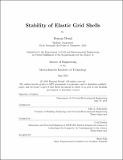| dc.contributor.advisor | John A. Ochsendorf and Cyril Douthe. | en_US |
| dc.contributor.author | Mesnil, Romain, M. Eng. Massachusetts Institute of Technology | en_US |
| dc.contributor.other | Massachusetts Institute of Technology. Department of Civil and Environmental Engineering. | en_US |
| dc.date.accessioned | 2013-12-06T19:51:33Z | |
| dc.date.available | 2013-12-06T19:51:33Z | |
| dc.date.copyright | 2013 | en_US |
| dc.date.issued | 2013 | en_US |
| dc.identifier.uri | http://hdl.handle.net/1721.1/82716 | |
| dc.description | Thesis (M. Eng.)--Massachusetts Institute of Technology, Dept. of Civil and Environmental Engineering, 2013. | en_US |
| dc.description | This electronic version was submitted by the student author. The certified thesis is available in the Institute Archives and Special Collections. | en_US |
| dc.description | Cataloged from student-submitted PDF version of thesis. | en_US |
| dc.description | Includes bibliographical references (p. 83-86). | en_US |
| dc.description.abstract | The elastic grid shell is a solution that combines double curvature and ease of mounting. This structural system, based on the deformation of an initially at grid without shear stiffness was invented more than fifty years ago. The apparition of new materials such as GFRP increased the potential of such structures whose properties depend on the deformation, or equivalently pre-stress of an initial structure. Elastic grid shells seem particularly promising as shelters, lightweight roofs, or kinetic structures. Although fundamental to the behavior of the strucure, the influence of the pre-stress on the stability of elastic grid shells has yet to be studied. Understanding this phenomenon could allow engineers to design more efficiently elastic grid shells. This thesis studies the influence of pre-stress on the stability of elastic grid shells. The research conducts a parametric study that focuses both a pre-buckled arch and initially at circular elastic grid shells with dierent grid spacing and levels of pre-stress. Realistic values of the parameters are determined from existing projects. The buckling analysis as well as the form-finding of the different structures are performed using finite element analysis. The tools are validated with comparison of the shape and buckling capacity of a pre-buckled arch with existing experiments. The parametric studies lead to recommendations aiming to facilitate the design of elastic grid shells. Keywords Elastic grid shell, Low-Speed Dynamics, form-finding, linear buckling analysis | en_US |
| dc.description.statementofresponsibility | by Romain Mesnil. | en_US |
| dc.format.extent | 114 p. | en_US |
| dc.language.iso | eng | en_US |
| dc.publisher | Massachusetts Institute of Technology | en_US |
| dc.rights | M.I.T. theses are protected by
copyright. They may be viewed from this source for any purpose, but
reproduction or distribution in any format is prohibited without written
permission. See provided URL for inquiries about permission. | en_US |
| dc.rights.uri | http://dspace.mit.edu/handle/1721.1/7582 | en_US |
| dc.subject | Civil and Environmental Engineering. | en_US |
| dc.title | Stability of elastic grid shells | en_US |
| dc.type | Thesis | en_US |
| dc.description.degree | M.Eng. | en_US |
| dc.contributor.department | Massachusetts Institute of Technology. Department of Civil and Environmental Engineering | |
| dc.identifier.oclc | 862819406 | en_US |
